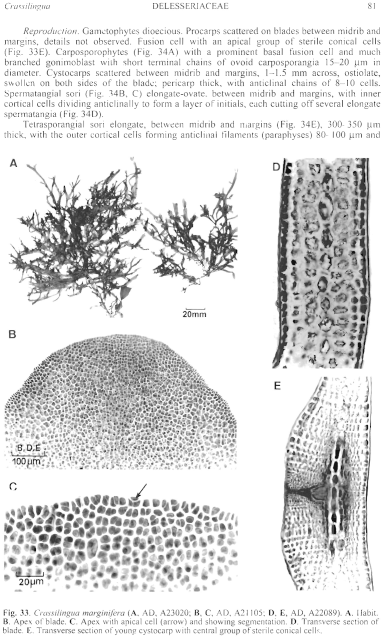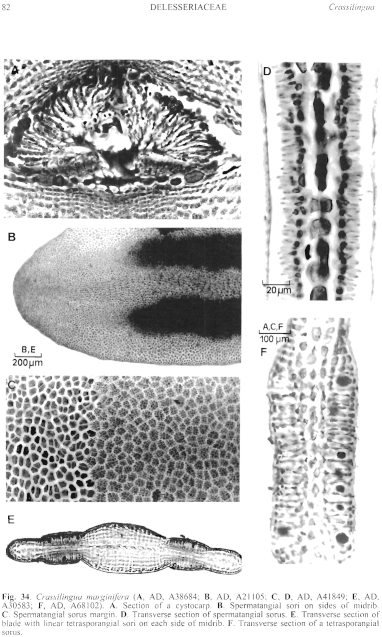|
|
|
|
|
|||||||||||
|
Electronic Flora of South Australia Species Fact Sheet
Phylum Rhodophyta – Family Delesseriaceae
Selected citations: May 1965: 352, 400. Shepherd & Womersley 1970: 135; 1981: 366. Silva et al. 1996: 454.
Synonyms
Delesseria marginifera J. Agardh 1885: 70. Tisdall 1898: 509. Wilson 1892: 174.
Pachyglossum marginiferum (J. Agardh) J. Agardh 1898: 126. De Toni 1900: 683. Kylin 1924: 50, fig. 41; 1956: 442, fig. 353. Lucas 1909: 36. Papenfuss 1956: 160.
Pachyglossum husseyanum J. Agardh 1894: 65; 1898: 127. De Toni 1900: 684. Kylin 1924: 51; 1956: 442. Lucas 1909: 36; 1929b: 50. Lucas & Perrin 1947: 226. Papenfuss 1956: 160. Reinbold 1897: 54.
Crassilingua husseyana (J. Agardh) May 1965: 352, 400. Wynne 1996: 179.
Nitophyllum proliferum J. Agardh 1894: 63; 1899, pl. 3 figs 1–3. De Toni 1900: 636. Lucas 1909: 35; 1926: 599, pl. 38 figs 3, 4, pl. 39 fig. 1.
Pachyglossum proliferum (J. Agardh) Kylin 1924: 50. Papenfuss 1956: 160.
Crassilingua prolifera (J. Agardh) May 1965: 352, 400.
Pachyglossum engelhardtii J. Agardh 1898: 126. De Toni 1900: 683. Kylin 1924: 50. Lucas 1909: 36; 1929b: 50. Lucas & Perrin 1947: 226. Papenfuss 1956: 160.
Crassilingua engelhardtii (J. Agardh) May 1965: 352, 400.
Pachyglossum ovale J. Agardh 1898: 127. De Toni 1900: 684. Kylin 1924: 50. Lucas 1909: 36.
Thallus (Fig. 33A) medium to dark red-brown, 5–20 (–30) cm high, irregularly much branched with linear laterals borne marginally or proliferously from within the margin. Main branches 3–6 (–8) mm broad, lesser branches 2–4 mm broad, with short constricted stipes, apices rounded; all branches with a broad, central midrib but no lateral veins. Holdfast divided, fibrous with rhizoids, 2–5 (–10) mm across; epilithic or rarely epiphytic. Structure. Apical cell (Fig. 33B, C) obconical but indistinct, segmenting to an axial filament and 2 lateral pericentral cells which form second-order cell rows reaching the thallus margin, with the cells cutting off irregularly third-order cells or rows both abaxially and adaxially (Fig. 33C); transverse pericentral cells not recognisable as such. Transverse intercalary divisions occur in axial and other cells, giving a compact but irregular cell arrangement in surface view. Cortication commencing close to apices, with the blades soon becoming polystromatic (Fig. 33D) and 120–160 µm thick, with a central layer of large, isodiametric to ovoid, cells 35–60 µm across and usually 2 layers of smaller, isodiametric and angular cells 10–15 µm across; margins 250–300 thick due to slight separation of the 5 layers of cells. Midrib broad, with 4–8 cell layers over 10–20 primary cells in transverse section. Mature cells multinucleate; rhodoplasts discoid.
Reproduction: Gametophytes dioecious. Procarps scattered on blades between midrib and margins, details not observed. Fusion cell with an apical group of sterile conical cells (Fig. 33E). Carposporophytes (Fig. 34A) with a prominent basal fusion cell and much branched gonimoblast with short terminal chains of ovoid carposporangia 15–20 µm in diameter. Cystocarps scattered between midrib and margins, 1–1.5 mm across, ostiolate, swollen on both sides of the blade; pericarp thick, with anticlinal chains of 8–10 cells. Spermatangial sori (Fig. 34B, C) elongate-ovate, between midrib and margins, with inner cortical cells dividing anticlinally to form a layer of initials, each cutting off several elongate spermatangia (Fig. 34D).
Type from "oras occid. Aust." (see below); lectotype in Herb. Agardh, LD, 31467.
Selected specimens: Elliston, S. Aust., 17 m deep outside bar (Shepherd, 12.v.1971; AD, A38684). Wanna, S. Aust., drift (Shepley, 19.ii.1959; AD, A22236). Whale Point, West I., S. Aust., 13 m deep (Shepherd, June 1966; AD, A30583). Port Elliot, S. Aust., drift (Womersley, 17.v.1960; AD, A24371). Middleton, S. Aust., drift (Womersley, 12.vi.1950; AD, A13078). N of Cape Thomas, Guichen Bay, S. Aust., drift (Womersley, 24.viii.1960; AD, A24391). 23 km NW of Robe, S. Aust., 40 m deep (Shepherd, 20.xi.1968; AD, A33105). Robe, S. Aust., drift (Womersley, 15.iv.1959; AD, A23020 and 2.iv.1999; AD, A68102) and 1–3 m deep on jetty piles (Gilbert, 21.ii.1986; AD, A56970). Stinky Bay, Nora Creina, S. Aust., on Ballia callitricha, drift (Womersley, 19.viii.1957; AD, A21105) and (Shepley, 2.ix.1958; AD, A22089). 1.3 km off Cape Northumberland, S. Aust., 15 m deep (Shepherd, 13.ii.1976; AD, A47019 and 26.x.1977; AD, A55276). Warrnambool, Vic., drift (Womersley, 13.iv.1959; AD, A22952). Port Phillip Heads, Vic., 30–32 m deep (Saunders et al., 20.ii.1995; MELU, K10520). Gabo I., Vic., 13 m deep (Shepherd, 14.ii.1973; AD, A43342). North Point, Eaglehawk Neck, Tas., 16–21 m deep (Kraft, 12.xii.1993; MELU, K9663). Fluted Cape, Bruny I., Tas., 16 m deep (Shepherd, 14.ii.1972; AD, A41849). Great Taylor Bay, Bruny I., Tas., 4 m deep (Shepherd, 14.ii.1972; AD, A42030).
Distribution: Western Australia(?) and Elliston, S. Aust., to Gabo I., Vic., and SE Tasmania.
Taxonomic notes: 4–7 cells long, surrounding the ovoid tetrasporangia (Fig. 34F), 30–40 µm in diameter, which are borne terminally on 2–4-celled filaments.
C. marginifera occurs mainly in deep water or shallow but shaded positions on rough water coasts.
The original description of C. marginifera gave only "occid. Aust." as locality, and the lectotype in Herb. Agardh is accompanied by a drawing with "Merrifield" and also "West Australia" on the sheet. The species is not otherwise known from Western Australia.
Pachyglossum husseyanum J. Agardh (1894, p. 65) is based on a specimen from Port Elliot, S. Aust. (Hussey); the lectotype in Herb. Agardh, LD, 31490, is identical with C. marginifera.
Nitophyllum proliferum J. Agardh (1894, p. 63) is based on a specimen from Port Phillip Heads, Victoria (Wilson); the holotype in Herb. Agardh, LD, 30432, is irregularly proliferous from the edge of the relatively broad (0.5–1 cm wide) main blades, with tetrasporangial sori in a straight line just within the margins. These differences are probably within the habit range of the species.
Pachyglossum engelhardtii J. Agardh (1898, p. 126) is based on a specimen of Engelhardt, probably from SE South Australia; the lectotype in Herb. Agardh, LD, 31475, has rather pointed branches, mainly but not entirely marginal, and is probably only a young plant of the species.
Pachyglossum ovale J. Agardh (1898, p. 127) is based on specimens of Wilson from Port Phillip, Vic., and, as Kylin (1924, p. 50) noted, are the same as P. proliferum (= C. marginifera).
References:
AGARDH, J.G. (1885). Till algernes systematik. VII. Florideae. Acta Univ. lund. 21, 1–120, Plate 1.
AGARDH, J.G. (1894). Analecta Algologica. Cont. II. Acta Univ. lund. 30, 1–98, Plate 1.
AGARDH, J.G. (1898). Species Genera et Ordines Algarum. Vol. 3, Part 3 - De dispositione Delesseriearum. (Gleerup: Lund.)
AGARDH, J.G. (1899). Analecta Algologica. Cont. V. Acta Univ. lund. 35, 1–160, Plates 1–3.
DE TONI, G.B. (1900). Sylloge Algarum omnium hucusque Cognitarum. Vol. 4. Florideae. Sect. 2. pp. 387–776. (Padua.)
KYLIN, H. (1924). Studien über die Delesseriaceen. Lunds Univ. Årsskr. N.F. Avd. 2, 20(6), 1–111.
KYLIN, H. (1956). Die Gattungen der Rhodophyceen. (Gleerups: Lund.)
LUCAS, A.H.S. & PERRIN, F. (1947). The Seaweeds of South Australia. Part 2. The Red Seaweeds. (Govt Printer: Adelaide.)
LUCAS, A.H.S. (1909). Revised list of the Fucoideae and Florideae of Australia. Proc. Linn. Soc. N.S.W. 34, 9–60.
LUCAS, A.H.S. (1926). Notes on Australian marine algae. III. The Australian species of the genus Nitophyllum. Proc. Linn. Soc. N.S.W. 51, 594–607, Plates 37–45.
LUCAS, A.H.S. (1929b). A census of the marine algae of South Australia. Trans. R. Soc. S. Aust. 53, 45–53.
MAY, V. (1965). A census and key to the species of Rhodophyceae (red algae) recorded from Australia. Contr. N.S. W. Natl Herb. 3, 349–429.
PAPENFUSS, G.F. (1956). On the nomenclature of some Delesseriaceae. Taxon 5, 158–162.
PAPENFUSS, G.F. (1958). Notes on algal nomenclature. IV. Taxon 7, 104–109.
REINBOLD, T. (1897). Die Algen der Lacepede und Guichen Bay und deren náherer Umgebung (Slid Australien), gesammelt von Dr. A. Engelhart-Kingston. Nuova Notarisia 8, 41–62.
SHEPHERD, S.A. & WOMERSLEY, H.B.S. (1970). The sublittoral ecology of West Island, South Australia: 1. Environmental features and algal ecology. Trans. R. Soc. S. Aust. 94, 105–137, Plate 1.
SHEPHERD, S.A. & WOMERSLEY, H.B.S. (1981). The algal and seagrass ecology of Waterloo Bay, South Australia. Aquat. Bot. 11, 305–371.
SILVA, P.C., BASSON, P.W. & MOE, R.L. (1996). Catalogue of the Benthic Marine Algae of the Indian Ocean. (Univ. California Press: Berkeley.)
TISDALL, H.T. (1898). The algae of Victoria. Rep. 7th Meet. Aust. Ass. Adv. Sci., Sydney, 1898, pp. 493–516.
WILSON, J.B. (1892). Catalogue of algae collected at or near Port Phillip Heads and Western Port. Proc. R. Soc. Viet. 4, 157–190.
WYNNE, M.J. (1996). A revised key to genera of the red algal family Delesseriaceae. Nova Hedwigia 112, 171–190.
The Marine Benthic Flora of Southern Australia Part IIID complete list of references.
Publication:
Womersley, H.B.S. (24 February, 2003)
The Marine Benthic Flora of Southern Australia
Rhodophyta. Part IIID. Ceramiales – Delesseriaceae, Sarcomeniaceae, Rhodomelaceae
Reproduced with permission from The Marine Benthic Flora of Southern Australia Part IIID 2003, by H.B.S. Womersley. Australian Biological Resources Study, Canberra. Copyright Commonwealth of Australia.
Illustrations in Womersley Part IIIA, 2003: FIGS 33, 34.

Figure 33 enlarge
Fig. 33. Crassilingua marginifera (A, AD, A23020; B, C, AD, A21105; D, E, AD, A22089). A. Habit. B. Apex of blade. C. Apex with apical cell (arrow) and showing segmentation. D. Transverse section of blade. E. Transverse section of young cystocarp with central group of sterile conical cells.

Figure 34 enlarge
Fig. 34. Crassilingua marginifera (A, AD, A38684; B, AD, A21105; C, D, AD, A41849; E, AD, A30583; F, AD, A68102). A. Section of a cystocarp. B. Spermatangial sori on sides of midrib. C. Spermatangial sorus margin. D. Transverse section of spermatangial sorus. E. Transverse section of blade with linear tetrasporangial sori on each side of midrib. F. Transverse section of a tetrasporangial sorus.

|
Email Contact: State Herbarium of South Australia |

|